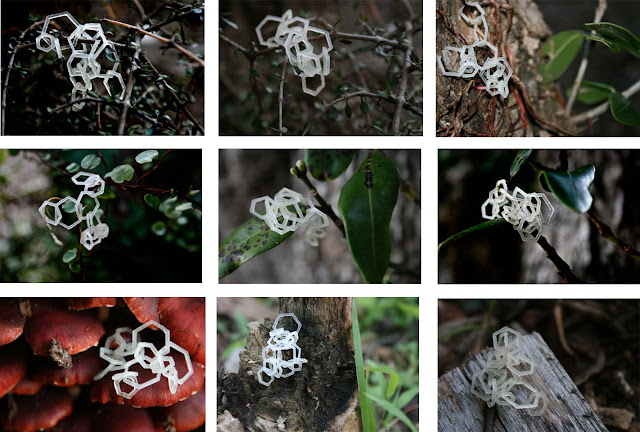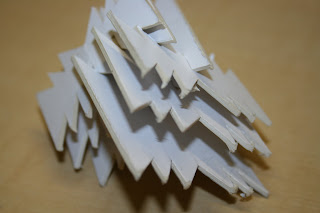My proposal for my interactive object is a series of boxes, which all hold different objects. The user has a list of the objects but is unaware of which box holds each object. The objective is to use senses other than sight to decide which object they think is in each box. I think that this will be an exciting and interesting interaction as the user is unaware of which objects are inside and will have to use senses which they don't normally use to decipher an object, as we usually identify an object by the way it looks. The user will also have a rewarding or satisfying feeling if they can correctly identify the objects without looking at them.
Saturday, 23 July 2011
Class work (click image to enlarge)
These are my notes from the class exercise where we all provided three interactive objects. I found this really useful because we discussed what senses each object used and worked backwards to discover what the original intent behind these objects was. With this task we were moving further away from the objects and beginning to look at what sensory experience each object provided.
Thursday, 16 June 2011
Final photograph
This is my final photograph of my model. I think that putting it into a natural environment was a good decision as it effectively conveys that I wanted my model to seem lifelike, organic and natural. I think that in this photograph, due to the area of focus, the hexagonal shape which I used to form my model is predominant, while still giving a good view of my whole form.
My model itself was quite a risk. Having the hexagonal shapes interlinking came with the risk of my model collapsing into a heap once printed in 3D. However, I think that this risk payed off and my model is really intresting and changable and can be made into endless different forms when played around with.
Final render.
This is my final render. I think that putting my models into a setting was quite a risk as it could detract from my models rather than add to them, however, I think that through the combination of textures, shading and this setting in particular, my models are easily visible and stand out from the backdrop. I think that having my final model on the concrete part of the background draws your eye to this model, which is what I was hoping to achieve. Having the models rendered in an environment also tells us a lot about my models, indicating that I wanted them to appear organic and natural. This wouldn't have been achieved through using a plain backdrop. The use of textures and bmp's also adds to the overall, lifelike scene.
Photographs
When it came to photographing my model I decided that putting my model into a natural environment would be the most appropriate considering my orgional definition of pattern:
'A natural or chance marking, configuration, or design.'
and my 6 precedent images which are all images from nature. I wanted to carry this theme throughout my project and think i have achieved this. I wanted my model to almost seem 'lifelike' like a plant or some form fungus. therefor, i took multiple photos of my model within an outside setting. Here are some of the images i took:
Test Renders
Using the textures i gathered and some backdrop images i started trailing different renders. Here are some of the images i came up with.
Textures
When it came to rendering my models and adding textures to them i thought that organic textures would suit my models and precedent images. I looked up some textures on google and also took some of my own photos.
Google images:
Images I took:
Wednesday, 15 June 2011
Final Model
This is my final model which will be printed in 3D. It's a series of hexagonal, honey comb shapes all interlinked. I used multiples sizes and linked them all together in different directions. I then used the 'twist' modifier to slightly morph the shapes. I think this is quite a risk as once printed all the rings will slide around eachother and the model could end up just collapsing and not really looking like a 3D form. However, the way i've linked them means that hopefully they will all sit onto of eachother making a really interesting, changeable 3D form.
Thursday, 9 June 2011
Solid Works
Here are some development images of my models in Solidworks which i will then put into 3dsMax and edit using the modifiers.
Tuesday, 7 June 2011
After researching my definition of pattern and precedent images i decided that the beehive or honeycomb was the most interesting pattern. I have always found it very interesting that the pattern is so perfectly repeated yet is made by these small insects. I also found it interesting that the bees themselves have a striped pattern on their body. A webpage, http://www.bioteams.com/2007/05/21/bees_and_pattern.html, quotes that 'Pattern recognition skills in bees are so advanced they can recognize human faces better than we can' clearly showing that pattern is such an important part of these insects and how they operate.
Monday, 16 May 2011
Design presedents
While looking through the design webpages and google images i came across these six precedents which all caught my eye. Each images relates well to the 'natural' aspect of pattern which i decided to focus on. Most of these are natural, organic patterns found in an outside environment. The last two images, although not actual photos of an organic form, are generated from nature. The doily type images is generated from silhouettes of flowers and leaves and the last image is a topographic map where the pattern is created by the different lines describing the formation of the land. I also found interesting the irony of the first image. Although the crops themselves are completely natural the way they form this linear pattern is very controlled and manmade.
Project 3. Define Pattern.
After researching the definition of pattern i came up with multiple different options:
Each definition is similar, talking about a 'design' but i decided i prefer the first definition as it talks about the 'natural'. This leaves me with many options to explore when looking for design precedents as lots of organic forms have natural patterning.
'A natural or chance marking, configuration, or design.'
'An artistic or decorative design.'
'A repeated decorative design.'
'A design of natural or accidental origin.'Each definition is similar, talking about a 'design' but i decided i prefer the first definition as it talks about the 'natural'. This leaves me with many options to explore when looking for design precedents as lots of organic forms have natural patterning.
Monday, 9 May 2011
Revised Render
This revised render achieves the same contrast as in my photograph of my model. The clean, elegant and very structured form is contrasted with the cracked, gritty background making my model jump out from the page.
Model
Final image of my laser cut model- Combination of card and acrylic with small triangular etch.
I tried to give my model and overall delocate and detailed appearance, hence the fine etching, which is then contrasted by the sharp edges of the model when picked up. I think the warm bright colouring combined with the dark black shaddows helps aid this contast. I also tried to form my model so that is didnt have one particular way of sitting, encouraging people to pick it up and interact with it- feeling the texture of the etch and the sharp edges.
I tried to give my model and overall delocate and detailed appearance, hence the fine etching, which is then contrasted by the sharp edges of the model when picked up. I think the warm bright colouring combined with the dark black shaddows helps aid this contast. I also tried to form my model so that is didnt have one particular way of sitting, encouraging people to pick it up and interact with it- feeling the texture of the etch and the sharp edges.
Subscribe to:
Comments (Atom)
















































